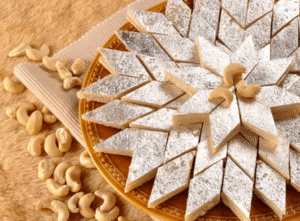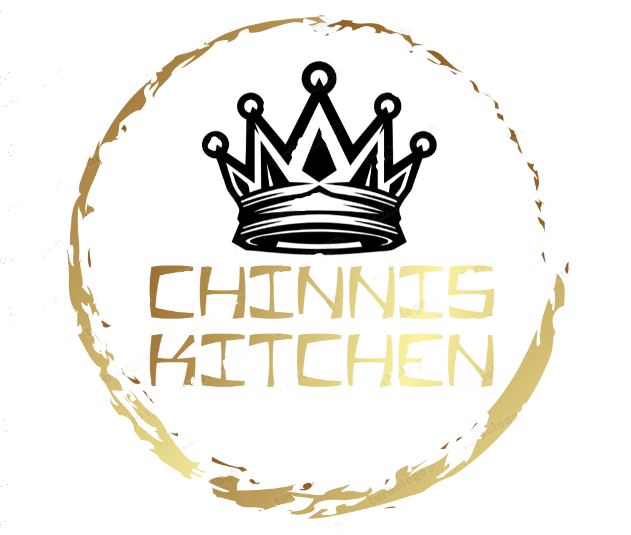Kaju Katli, also known as Kaju Barfi, is a popular Indian dessert made primarily from cashew nuts and sugar. The name translates to “cashew slice,” reflecting its main ingredient and typical diamond shape. The preparation involves soaking cashews, grinding them into a paste, and cooking with sugar syrup to form a dough. This dough is then flattened and cut into diamond-shaped pieces, often adorned with edible silver foil (varak) for a festive touch.
Kaju Katli is especially popular during festivals like Diwali and is commonly used as a gift due to its rich taste and elegant appearance. Variations of the sweet may include ingredients like saffron (kesar) or rose water to enhance its flavour.
Kaju Katli, also known as Kaju Barfi, is a cherished Indian sweet made primarily from cashew nuts and sugar. Its origins are steeped in rich history, with multiple narratives attributing its creation to different periods and regions in India.

Mughal Era Origins
A widely accepted account traces Kaju Katli back to the opulent kitchens of the Mughal Empire. During this era, chefs were known for their culinary innovations, often blending Persian techniques with local ingredients. Cashews, introduced to India by Portuguese traders, were considered a luxury item. Mughal chefs crafted a delicate sweet by grinding cashews into a fine paste and combining it with sugar and ghee, resulting in the smooth, diamond-shaped Kaju Katli we know today.
Maratha Legend
Another narrative credits the Maratha Empire with the invention of Kaju Katli. According to this account, a 16th-century Maratha chef named Bhimrao was inspired by a Persian sweet called Halwa-e-Farsi, traditionally made with almonds. He substituted cashews for almonds, creating a new delicacy that was well-received by the Maratha royalty. This version of the sweet, characterized by its thin slices, became known as Kaju Katli.
Symbol of Liberation
A poignant story links Kaju Katli to a significant event during the reign of Mughal Emperor Jahangir. In 1619, Guru Hargobind, the sixth Sikh Guru, was imprisoned along with 52 kings in Gwalior Fort. Upon their release, which coincided with the festival of Diwali, the emperor’s royal chef prepared a special sweet to commemorate the occasion. This sweet, made from cashews and sugar, was said to be the first Kaju Katli, symbolizing freedom and celebration.
Modern-Day Significance
Today, Kaju Katli holds a special place in Indian festivities, especially during Diwali. Its smooth texture and rich flavor make it a favorite among sweets. Often adorned with edible silver foil (varak), it symbolizes prosperity and is commonly exchanged as a gift during celebrations. Over time, variations like chocolate-infused or saffron-flavored Kaju Katli have emerged, catering to diverse palates.
While the exact origins of Kaju Katli may be debated, its enduring popularity is a testament to its delightful taste and cultural significance. Whether you prefer the Mughal, Maratha, or liberation tale, each story adds depth to this beloved Indian sweet.
Ingredients
-
1½ cups (200 grams) cashew nuts
-
¾ cup (150 grams) white sugar
-
6 tablespoons (90 ml) water
-
1 teaspoon rose water or ⅛ teaspoon cardamom powder (optional)
-
2 teaspoons ghee (for cooking)
-
1 teaspoon ghee (for greasing)
-
Edible silver leaf (varak) – optional, for decoration
Note: Ensure cashews are at room temperature before starting.
Instructions
1. Prepare Cashew Powder
-
If cashews are refrigerated, allow them to come to room temperature.
-
Place the cashews in a grinder or food processor. Pulse a few times until they turn into a fine powder.
-
Avoid over-grinding, as cashews can release oil and become pasty.
-
For a smoother texture, you may sieve the powder and re-grind any coarse particles
2. Make Sugar Syrup
-
In a non-stick or heavy-bottomed pan, combine sugar and water.
-
Heat the mixture until the sugar dissolves completely and begins to boil rapidly.
3. Cook Cashew Mixture
-
Reduce the heat to low and add the cashew powder to the boiling sugar syrup.
-
Stir continuously to blend the mixture smoothly, ensuring there are no lumps.
-
Cook on medium heat for about 5 minutes until the mixture thickens slightly.
-
Add rose water or cardamom powder (if using) and 1 teaspoon ghee. Mix well.
-
Continue cooking for another 4 minutes until the mixture leaves the sides of the pan and has a moist, sticky consistency.
4. Knead the Dough
-
Grease a clean surface or plate with ghee.
-
Transfer the hot mixture onto the greased surface.
-
Allow it to cool slightly until it’s comfortable to handle.
-
Knead the mixture gently to form a smooth, soft dough.
5. Shape and Decorate
-
Place the dough between two sheets of parchment paper or on a greased surface.
-
Roll it out evenly to about ¼-inch thickness.
-
If desired, apply edible silver leaf on top for decoration.
-
Cut the rolled dough into diamond-shaped pieces using a sharp knife.
6. Cool and Store
-
Allow the Kaju Katli pieces to cool completely.
-
Store them in an airtight container.
-
At room temperature: up to 8–10 days.
-
In the refrigerator: up to a month.
-
